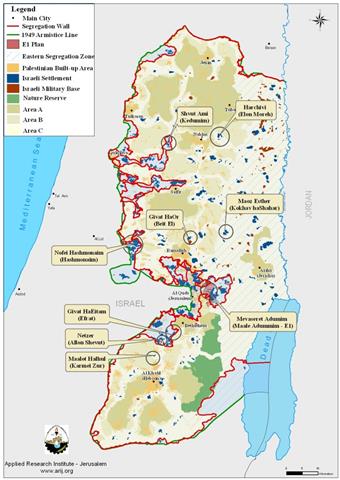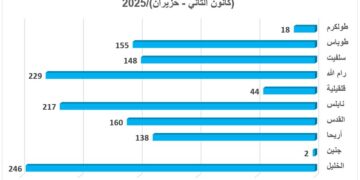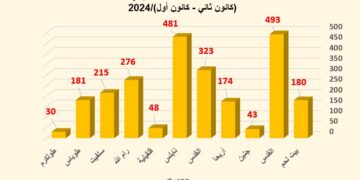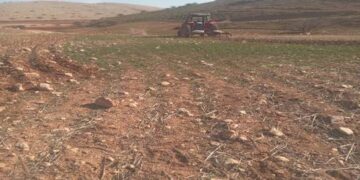The Israeli daily newspaper Haaretz reported that some Jewish Settlers' groups marched towards several locations in the West Bank in an attempt to set up nine new settlements' outposts. The inauguration of these outposts was planned to take place, as declared by the settlers, on the 9th of December 2007 with the goal of establishing permanent communities to settle new Jewish families in them. Organizations supporting settlers' actions are 'Land of Israel Faithful', 'Youth for Eretz Yisrael', Women in Green and the local grassroots action committees. The locations targeted to establish the outposts near settlements are
1. Harchivi, near Elon Moreh in Nablus Governorate.
2. Shvut Ami, near Kedumim in Salfit Governorate
3. Maoz Esther (Esther's Stronghold), near Kochav HaShachar (Ramallah Governorate)
4. Givat Ha'Or ('Hilltop of the Light'), 1.5 km south of Beit El settlement in Ramallah Governorate
5. Mevasseret Adumim outpost, located in E1 area in Ramallah Governorate.
6. Nofei Hashmona'im, near Hashmona'im settlement in Ramallah Governorate.
7. Ma'alot Halhul, near Kiryat Arba in Hebron Governorate
8. Netzer, near Alon Shvut in Bethlehem Governorate
9. Givat HaEitam, near Efrat, already established in Bethlehem Governorate.
On September 2, 2007, the Settlements' Council (Yesha council of Jewish settlers) announced their plans to establish five new outposts on five hilltops in the occupied West Bank. The council declared that this step is 'a continuation to the Zionist spirit of inhabitants of Israel. These outposts will be a hit to Israel's enemies at home and abroad who threatens the survival of the State'. See Tabl 1e
Table 1: Distribution of Ouposts in Regional Councils
|
Region |
Outpost Name |
|
Judea Area:
|
Givat HaEitam, near Efrat |
|
Giv'a hilltop 1013
|
|
|
Binyamin Area
|
Nofei Hashmonaim, near Hashmonaim |
|
Samaria Area: |
Shvut Ami, near Kedumim |
|
Harchivi, near Elon Moreh |
|
|
Source: Yesha council of Jewish settlers |
|
Two of the aforementioned five outposts were set in their locations and several Jewish families settled in, while the remaining three are among the sites to be by the end of December.
Some 200 Israeli settlers were reported marching towards 'Mevesert Adumim' site (within the E1 vicinity), which is one of the sites planned to be occupied by settlers in the area between the settlement of Ma'ale Adumim and Jerusalem city. The Israeli Government had in the previous years set up plans to build some 3500 housing units there to set up a geographical link between the Ma'ale Adumim settlements' bloc and settlements inside Jerusalem city. Israeli settlers expressed their anger from the Israeli Government giving up to the US pressure to stop settlements' activities in the West Bank, especially in Ma'ale Adumim saying that: 'the current Israeli government caved into the American pressure and stopped those plans' adding 'They do not let the Jews build there because E1 is meant to be the area that will give the Palestinians continuity for their planned Palestinian State. And thus, if we want to prevent the creation of a Palestinian State we must make sure to settle E1 – and fast.'
It is not the first time Israeli settlers try to establish new outposts. In Fact, the Israeli settlers have succeeded in their efforts and established dozens of outpost across the occupied territory. One example is Shvut Ami outpost near Kedumim settlement (one of Ariel's settlements bloc). The anticipated outpost is located on a hilltop, in close parameters from bypass road number 55 that links Kedumim settlement with Karne Shomron east of Qalqilyah city. The Israel police forces evacuated this outpost 6 times but settlers relentlessly rebuild it repeatedly. Today, the outpost contains two caravans and a shed.
Another example is the illegal outpost Tel Chaim or the locally known 'Beit El East'. This outpost was set up during the month of July 2003 by some teenagers who started planting pine trees. The Israeli Police tried to evacuate the outposts but the settlers responded viciously and with the anger and spiked nails and sharp objects in the ground to prevent the evacuation process by the Police. On their part, the Yesha council called upon settlers all over the West Bank to come and reinforce the right of the settlers to live there at the outpost and to oppose any order to evacuate it 'does not pass the line of 'passive resistance, in keeping with accepted democratic norms' as stated by the council.
An analysis conducted at Applied Research Institute Jerusalem (ARIJ) – showed that 220 Illegal Israeli outposts already exist in the occupied West Bank territory. See Table 2
|
Table 2: Distribution of Israeli Outposts in West Bank Governorates |
|
|
Governorate |
No. of outposts |
|
Bethlehem |
14 |
|
Hebron |
44 |
|
Jenin |
6 |
|
Jericho |
9 |
|
Jerusalem |
8 |
|
Nablus |
44 |
|
Qalqilyia |
18 |
|
Ramallah |
53 |
|
Salfit |
17 |
|
Tubas |
3 |
|
Tulkarem |
4 |
|
Total |
220 |
|
Source: ARIJ GIS Database 2007 |
|
The Israeli settlements' outposts remain one of the major impediments to the advancement of the peace, process. The Israelis on their part try to classify the outposts in the legal manner, by defining parts of them as legal and other as illegal, and by doing so the cast some sort of legitimacy on part of them. Moreover, out of the 220 outposts that exit today, 87 established within an existing settlement's master plan area, which in turn maybe defined as new neighborhoods. As for the remaining 133 outposts, they that exist in newly grabbed areas where the Israeli settlers attempt to turn these sites to completely new settlements later on. Another misleading information the Israelis try to circulate is that not all the outposts location are known or established with the knowledge of the Israeli government, however, facts on the ground say otherwise that the Israeli Army is the faithful escort to every settlers attempt to establish an outpost, to provide security and to give them the infrastructure needed to carry out the plan.
Prepared by
The Applied Reserach Institute – Jerusalem














